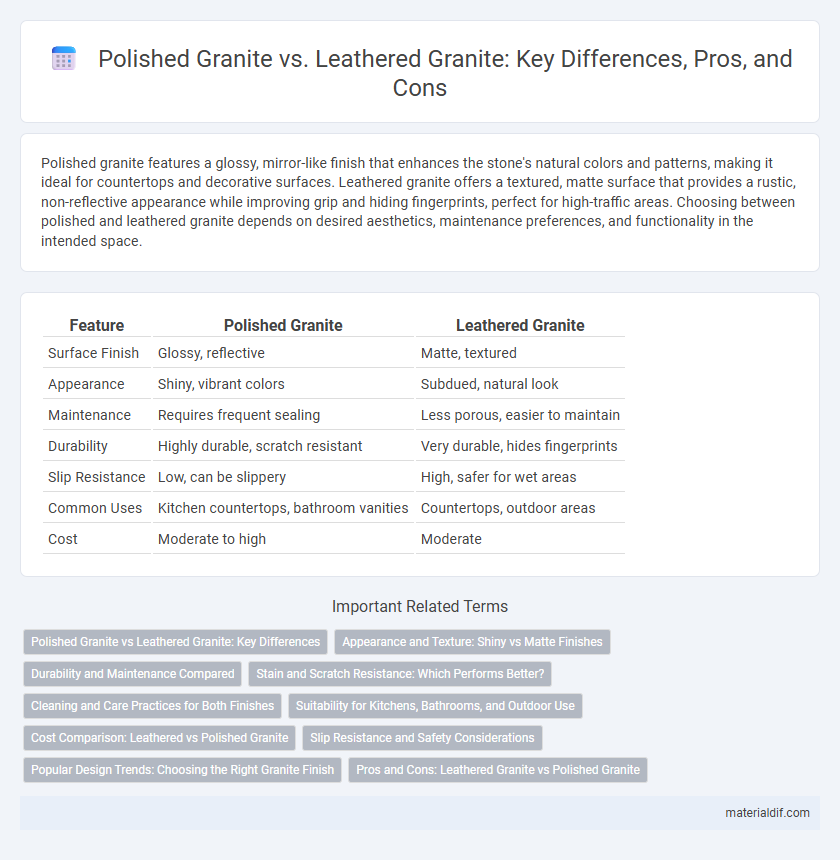Polished granite features a glossy, mirror-like finish that enhances the stone's natural colors and patterns, making it ideal for countertops and decorative surfaces. Leathered granite offers a textured, matte surface that provides a rustic, non-reflective appearance while improving grip and hiding fingerprints, perfect for high-traffic areas. Choosing between polished and leathered granite depends on desired aesthetics, maintenance preferences, and functionality in the intended space.
Table of Comparison
| Feature | Polished Granite | Leathered Granite |
|---|---|---|
| Surface Finish | Glossy, reflective | Matte, textured |
| Appearance | Shiny, vibrant colors | Subdued, natural look |
| Maintenance | Requires frequent sealing | Less porous, easier to maintain |
| Durability | Highly durable, scratch resistant | Very durable, hides fingerprints |
| Slip Resistance | Low, can be slippery | High, safer for wet areas |
| Common Uses | Kitchen countertops, bathroom vanities | Countertops, outdoor areas |
| Cost | Moderate to high | Moderate |
Polished Granite vs Leathered Granite: Key Differences
Polished granite features a glossy, reflective surface achieved through buffing, enhancing its natural colors and making it ideal for sleek countertops and elegant interiors. Leathered granite has a textured, matte finish created by brushing the stone, which hides fingerprints and scratches while providing a more rustic, tactile aesthetic. The key differences lie in their finish and maintenance: polished granite requires frequent cleaning to maintain shine, whereas leathered granite offers better slip resistance and durability, especially in high-traffic areas.
Appearance and Texture: Shiny vs Matte Finishes
Polished granite features a glossy, reflective surface that enhances the stone's natural colors and intricate patterns, making it ideal for high-end countertops and decorative applications. Leathered granite offers a matte finish with a slightly textured, soft sheen that provides a more natural, rustic look while hiding fingerprints and smudges better than polished granite. The choice between polished and leathered granite significantly impacts the visual appeal and tactile experience of the stone in interior design.
Durability and Maintenance Compared
Polished granite features a glossy, reflective surface that is highly resistant to scratches and stains, making it a durable choice for countertops with straightforward maintenance requiring regular cleaning and occasional sealing. Leathered granite, with its textured, matte finish, offers enhanced resistance to fingerprints and smudges while maintaining strong durability against everyday wear, often requiring less frequent sealing but more attentive cleaning to preserve its unique texture. Both finishes provide long-lasting durability, but polished granite excels in ease of maintenance, whereas leathered granite offers a subtle, low-maintenance alternative with natural resistance to minor surface imperfections.
Stain and Scratch Resistance: Which Performs Better?
Polished granite features a glossy finish that enhances its natural colors but is more prone to showing stains and scratches compared to leathered granite. Leathered granite has a textured surface that better masks stains and minor scratches, making it more resistant in high-traffic areas. Both finishes offer durability, but leathered granite provides superior stain and scratch resistance for active environments.
Cleaning and Care Practices for Both Finishes
Polished granite requires gentle cleaning with a pH-neutral cleaner and a soft cloth to maintain its glossy, reflective surface while avoiding scratches and dulling. Leathered granite offers a textured, matte finish that hides fingerprints and smudges but needs regular dusting and non-abrasive cleaners to prevent buildup in its crevices. Both finishes benefit from immediate spill cleanup to prevent staining, and periodic sealing enhances durability and protection against moisture and contaminants.
Suitability for Kitchens, Bathrooms, and Outdoor Use
Polished granite boasts a shiny, reflective surface that enhances color depth and is ideal for kitchens and bathrooms due to its stain resistance and ease of cleaning. Leathered granite features a textured, matte finish that offers better slip resistance, making it suitable for outdoor use and bathroom floors where safety is a priority. Both finishes provide durability, but polished granite excels in high-traffic kitchen countertops, while leathered granite is preferred for outdoor applications and wet areas requiring added grip.
Cost Comparison: Leathered vs Polished Granite
Leathered granite surfaces typically cost 10-20% more than polished granite due to the specialized finishing process that enhances texture and slip resistance. Polished granite, favored for its glossy appearance and ease of maintenance, generally comes at a lower price point, making it a budget-friendly choice for countertops and flooring. The price difference between leathered and polished granite varies based on the stone's origin, slab thickness, and installation complexity.
Slip Resistance and Safety Considerations
Polished granite features a glossy, reflective surface that can become slippery when wet, posing higher slip risks in areas prone to moisture. Leathered granite offers a textured, matte finish that enhances slip resistance, making it a safer option for high-traffic or wet environments such as kitchens and bathrooms. Choosing leathered granite improves safety by providing better traction without compromising the durability and natural beauty of the stone.
Popular Design Trends: Choosing the Right Granite Finish
Polished granite features a high-gloss, reflective surface that enhances the stone's natural colors and veining, making it a popular choice for sleek, modern kitchens and luxurious bathroom countertops. Leathered granite offers a textured, matte finish that adds depth and a tactile appeal, favored in rustic and industrial design trends for its ability to mask fingerprints and water spots. Selecting the right granite finish depends on the desired aesthetic, maintenance preferences, and how the surface will interact with light and usage in the space.
Pros and Cons: Leathered Granite vs Polished Granite
Polished granite features a glossy, reflective surface that enhances color depth and is highly resistant to stains but shows scratches and fingerprints more easily. Leathered granite offers a matte, textured finish that hides fingerprints and minor scratches better while providing a natural, rustic appearance but is slightly more porous and requires regular sealing. Choosing between leathered granite vs polished granite depends on your preference for shine and maintenance needs versus durability and a tactile, understated look.
Polished Granite vs Leathered Granite Infographic

 materialdif.com
materialdif.com